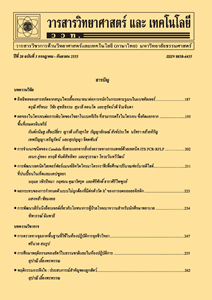การสังเคราะห์ คุณลักษณะ และการยับยั้งเชื้อแบคทีเรียของสารประกอบเชิงซ้อนของเหล็ก(III)-เหล็ก(II) และเหล็ก(III)-สังกะสี(II) กับลิแกนด์มัลติเดนเตท
Main Article Content
Abstract
บทคัดย่อ
สังเคราะห์ลิแกนด์มัลติเดนเตต H2L เมื่อ H2L คือ 2-[(บิส-ไพริดิล-2-อิลเมทิล-อะมิโน)-เมทิล]-6-{[(2-ไฮดรอกซิล-เบนซิล)-(4-อิมิดาโซล-1-อิล-บิวทิล)-อะมิโน]-เมทิล}-4-เมทิล-ฟีนอล และสังเคราะห์สารประกอบเชิงซ้อน M1M2L ได้จากสารตั้งต้นซึ่งเป็นเกลือของเหล็ก(III) และเหล็ก(II) สำหรับสารประกอบเชิงซ้อน 1 และเหล็ก(III) และสังกะสี(II) สำหรับสารประกอบเชิงซ้อน 2 ทำปฏิกิริยากับลิแกนด์ H2L ที่อุณหภูมิ 60 องศาเซลเซียส ผลจากการศึกษาสมบัติทางเคมีและตรวจหาลักษณะโครงสร้างของสารประกอบเชิงซ้อน 1 และ 2 โดยวิธีทางสเปกโทรสโกปี เช่น ฟูเรียร์ทรานสฟอร์มอินฟราเรด ลิควิดโครมาโท กราฟี แมสสเปกโทรเมตรี และยูวี-วิสิเบิล พบว่าสารประกอบเชิงซ้อนทั้งสองชนิดมีสูตรโมเลกุลเป็น [FeIIIFeII(L)(m-O)- (H2O)2](ClO4)×H2O (1) และ [FeIIIZnII(L)(m-O)(H2O)](ClO4) (2) และได้ศึกษาฤทธิ์การยับยั้งเชื้อแบคทีเรียของสารประกอบเชิงซ้อนเทียบกับลิแกนด์ที่สังเคราะห์ได้ โดยใช้แบคทีเรียชนิด คือ S. aureus และ E. coli ผลจากการศึกษาฤทธิ์การยับยั้งแบคทีเรียแสดงให้เห็นว่าสารประกอบเชิงซ้อนทั้งสองมีประสิทธิภาพในการยับยั้งแบคทีเรียทั้งสองชนิดดีกว่าลิแกนด์ที่ระดับความเข้มข้นเดียวกันและผลยับยั้งแบคทีเรียเมื่อเทียบกับเตตระซัยคลิน พบว่าที่ความเข้มข้นสูง ๆ สารประกอบเชิงซ้อนทั้งสองชนิดให้ประสิทธิภาพการยับยั้งแบคทีเรียใกล้เคียงกับเตตระซัยคลิน
คำสำคัญ : ลิแกนด์พอลีเดนเตท; สแตปฟิโลคอคคัส ออเรียส; เอสเชอริเชีย โคไล; ฤทธิ์ยับยั้งแบคทีเรีย
Abstract
2-[(Bis-pyridin-2-ylmethyl-amino)-methyl]-6-{[(2-hydroxy-benzyl)-(4-imidazol-1-yl-butyl)-amino]-methyl}-4-methyl-phenol (H2L), which is a multipolydentate ligand and cationic complexes of [M1M2L(m-O)(H2O)2]+ have been synthesized (where M1M2 are Fe(III)-Fe(II) for complex 1 and Fe(III)-Zn(II) for complex 2 and L is the anion of 2-[(Bis-pyridin-2-ylmethyl-amino)-methyl]-6-{[(2-hydroxy-benzyl)-(4-imidazol-1-yl-butyl)-amino]-methyl}-4-methyl-phenol. The reaction was set up at temperature 60oC. Two complexes were studied the physical and chemical properties and have been characterized using FT-IR, LC-MS with methanol solvent and UV-Vis techniques. Molecular formula of two complexes is [FeIIIFeII(L)(m-O)(H2O)2](ClO4)×H2O (1) and [FeIIIZnII(L)(m-O)(H2O)](ClO4) (2). The complexes and a multidentate ligand were tested for in vitro antibacterial activity against gram-positive bacteria, S.aureus and gram-negative bacteria, E.coli. The antibacterial activity was assessed by measuring the growth inhibition zones diameters. As a result, both complexes possess superior antibacterial activity than only multidentate ligand as the same concentration. An antibacterial effect is compared to tetracycline. It was found that the antibacterial activity is closed to tetracycline as two complexes have more concentration.
Keywords: polydentate ligand; Staphylococcus aureus; Escherichai coli; antibacterial activity


